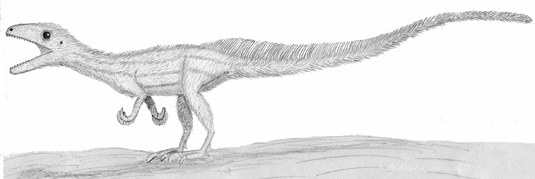Downy dinosaur discovered
The new fossil find from the chalk beds of the Franconian Jura evokes associations with a pet cemetery, for the young predatory dinosaur reveals clear traces of fluffy plumage. It also poses an intriguing question: Were all dinosaurs dressed in down?
03.07.2012

The fossil of the fledgling saurian, probably newly hatched when it met its end, is remarkable in many ways. First of all, juveniles are extremely rare in the dinosaur fossil record, so every new discovery provides insights into dinosaur nurseries. Moreover, this specimen is perhaps the best-preserved predatory dinosaur that has yet been found in Europe. And Sciurimimus albersdoerferi, which lived during the Jurassic Period some 150 million years ago, displays one very striking feature – its whole body must have been covered with a thick plumage of feathers.
All the feathered dinosaurs so far described belonged to the lineage that gave rise to modern birds. “However, Sciurumimus belongs to a much older branch of the family tree of predatory dinosaurs,” says LMU paleontologist Dr. Oliver Rauhut, who is also affiliated with the Bavarian State Collection for Paleontology and Geology, and led the investigation into the structure and affinities of the sensational new find. “Its plumage may be telling us that all predatory dinosaurs had feathers.”
Were all dinos decked out with feathers?
Several fossil finds have revealed that the pterosaurs – which were capable of flight and are the closest relatives of the dinosaurs – bore hair-like plumage on their bodies. Their fluffy coats resemble the downy feathers that can be recognized in the new fossil. This observation is very significant, as it suggests to the researchers that not just the pterosaurs and the predatory dinosaurs, but all dinosaurs may have had feathers. “If that is the case, we must abandon all our notions about giant reptiles encased in tough scales,” Rauhut says.
As the German-American research team led by Rauhut has been able to show, the new specimen represents a young megalosaur. The genus name Sciurumimus means “squirrel-like“ and refers to the animal’s bushy tail, while the species designation albersdoerferi honors the private collector who made the fossil available for scientific study. “When the skeleton was irradiated with UV light, we were able to discern fragments of the skin and the plumage as fluorescent spots and filaments,” says co-author Dr. Helmut Tischlinger.
Cute little dino kids
The juvenile Sciurumimus tells us even more. For instance, as in the case of other dinosaurs, its eyes were proportionately much larger than those of adult animals. In other words, young dinosaurs conformed to the “babyface” model. Secondly, it has long been suspected that not just the form of a dinosaur’s face, but also its whole mode of life, was subject to change during lifetime. “And indeed, this individual has a very different set of teeth from those found in adult megalosaurs,” says Rauhut. “That enables us to conclude that their diets also changed as they got older.”
The young Sciurumimus, with its slender, pointed teeth probably preyed on insects and small animals. Fully grown megalosaurs, on the other hand, often exceeded 6 m in length and may have weighed more than a ton, and could give other large dinosaurs a good run for their money. That may also be true of the new species. “We know that dinosaurs were able to grow at terrific rates; diminutive hatchlings could reach adult lengths of several meters,” Rauhut points out. “And even if they might have looked fluffy, they were certainly among the top predators in the food chain.” (suwe)
The study was financially supported by the Volkswagen Foundation and the American Museum of Natural History.
Contact
Or
Dipl.-Biol. Christian Foth
Email: christian.foth@yahoo.d





